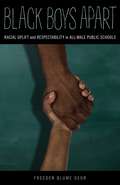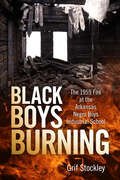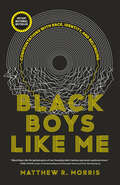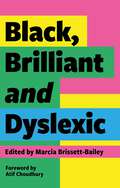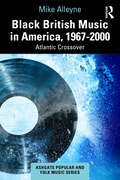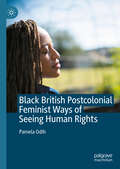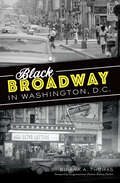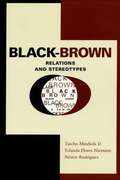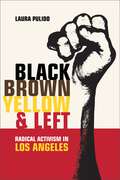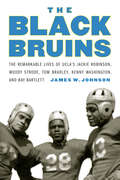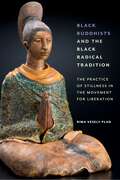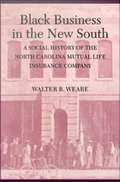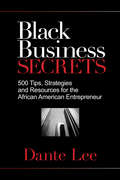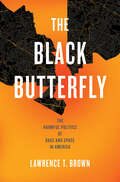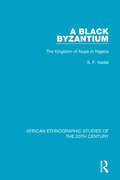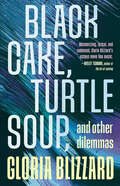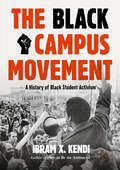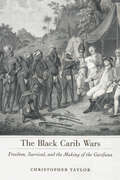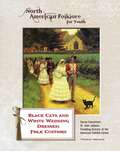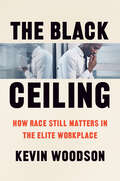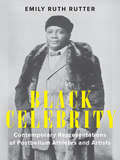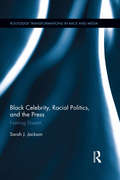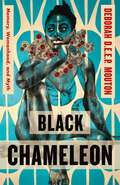- Table View
- List View
Black Boys Apart: Racial Uplift and Respectability in All-Male Public Schools
by Freeden Blume OeurHow neoliberalism and the politics of respectability are transforming African American manhood While single-sex public schools face much criticism, many Black communities see in them a great promise: that they can remedy a crisis for their young men. Black Boys Apart reveals triumphs, hope, and heartbreak at two all-male schools, a public high school and a charter high school, drawing on Freeden Blume Oeur&’s ethnographic work. We meet young men who felt their schools empowered and emasculated them, parents who were frustrated with co-ed schools, teachers who helped pave the road to college, and administrators who saw in Black male academies the advantages of privatizing education. While the two schools have distinctive histories and ultimately charted different paths, they were both shaped by the convergence of neoliberal ideologies and a politics of Black respectability. As Blume Oeur reveals, all-boys education is less a school reform initiative and instead joins a legacy of efforts to reform Black manhood during periods of stark racial inequality. Black male academies join long-standing attempts to achieve racial uplift in Black communities, but in ways that elevate exceptional young men and aggravate divisions within those communities. Black Boys Apart shows all-boys schools to be an odd mix of democratic empowerment and market imperatives, racial segregation and intentional sex separation, strict discipline and loving care. Challenging narratives that endorse these schools for nurturing individual resilience in young Black men, this perceptive and penetrating ethnography argues for a holistic approach in which Black communities and their allies promote a collective resilience.
Black Boys Burning: The 1959 Fire at the Arkansas Negro Boys Industrial School
by Grif StockleyOn the morning of March 5, 1959, Luvenia Long was listening to gospel music when a news bulletin interrupted her radio program. Fire had engulfed the Arkansas Negro Boys Industrial School in Wrightsville, thirteen miles outside of Little Rock. Her son Lindsey had been confined there since January 14, after a judge for juveniles found him guilty of stealing from a neighborhood store owner. To her horror, Lindsey was not among the forty-eight boys who had clawed their way through the windows of the dormitory to safety. Instead, he was among the twenty-one boys between the ages of thirteen and seventeen who burned to death. Black Boys Burning presents a focused explanation of how systemic poverty perpetuated by white supremacy sealed the fate of those students. A careful telling of the history of the school and fire, the book provides readers a fresh understanding of the broad implications of white supremacy. Grif Stockley’s research adds to an evolving understanding of the Jim Crow South, Arkansas’s history, the lawyers who capitalized on this tragedy, and the African American victims. In hindsight, the disaster at Wrightsville could have been predicted. Immediately after the fire, an unsigned editorial in the Arkansas Democrat noted long-term deterioration, including the wiring, of the buildings. After the Central High School desegregation crisis in 1957, the boys’ deaths eighteen months later were once again an embarrassment to Arkansas. The fire and its circumstances should have provoked southerners to investigate the realities of their “separate but equal institutions.” However, white supremacy ruled the investigations, and the grand jury declared the event to be an anomaly.
Black Boys Like Me: Confrontations with Race, Identity, and Belonging
by Matthew R. Morris&“Black Boys Like Me ignited parts of me I honestly didn't believe any book could ever know. . . . Seldom do incredibly titled books earn their titles. Matthew R. Morris earns this classic title with a classic book about our insides.&” —Kiese Laymon, author of Heavy Startlingly honest, bracing personal essays from a perceptive educator that bring us into the world of Black masculinity, hip-hop culture, and learning.This is an examination of the parts that construct my Black character; from how public schooling shapes our ideas about ourselves to how hip-hop and sports are simultaneously the conduit for both Black abundance and Black boundaries. This book is a meditation on the influences that have shaped Black boys like me.What does it mean to be a young Black man with an immigrant father and a white mother, teaching in a school system that historically has held an exclusionary definition of success?In eight illuminating essays, Matthew R. Morris grapples with this question, and others related to identity and perception. After graduating high school in Scarborough, Morris spent four years in the U.S. on multiple football scholarships and, having spent that time in the States experiencing &“the Mecca of hip hop and Black culture,&” returned home with a newfound perspective.Now an elementary school teacher himself in Toronto, Morris explores the tension between his consumption of Black culture as a child, his teenage performances of the ideas and values of the culture that often betrayed his identity, and the ways society and the people guiding him—his parents, coaches, and teachers—received those performances. What emerges is a painful journey toward transcending performance altogether, toward true knowledge of the self.With the wide-reaching scope of Desmond Cole&’s The Skin We&’re In and the introspective snapshot of life in Between the World and Me by Ta-Nehisi Coates, Black Boys Like Me is an unflinching debut that invites readers to create braver spaces and engage in crucial conversations around race and belonging.
Black, Brilliant and Dyslexic: Neurodivergent Heroes Tell their Stories
by Marcia Brissett-Bailey'My book showcases positive role models for black people and those within our wider dyslexic community and society, to inspire current and future generations.'This is a raw, honest and enlightening collection of experiences, across the black and dyslexic community, giving an intersectional perspective on topics including the education system, the workplace, daily life and entrepreneurship. These stories highlight the challenges, progress, successes and contributions of the black and dyslexic community, helping others to find their voice, feel empowered and be proud of their differences.It charts journeys from early childhood through to adulthood and, despite the lack of representation within the public arena, how black dyslexic people of all ages are changing the world.Raising awareness, breaking silences and tackling the stigma around dyslexia and the difficulties stemming from a lack of support. Contributors share how they tackled their unique adversities and provide practical tips for others to live proudly at the intersection of blackness and dyslexia.
Black British Music in America, 1967–2000: Atlantic Crossover (Ashgate Popular and Folk Music Series)
by Mike AlleyneBlack British Music in America 1967–2000: Atlantic Crossover historically examines musical and cultural relationships through popular music recordings, exploring the transatlantic journeys via academic, critical, and commercial reception of the music. It addresses an overlooked area of Black popular music, investigating the fluctuating fortunes of artists and the contradictions of exporting such recordings to America.Examining a complex history spanning the last four decades of the twentieth century, the author reveals the chronologies and the recording industry circumstances shaping the presence of Black British music in America. Readers will discover the conditions under which key recordings were made and released, through detailed analysis and new interviews with participating producers and artists. Including exploration of chart histories, this book also dissects the content of the recordings, uncovering the elements that made many of them successful.Black British Music in America 1967–2000 will interest all those who study popular music, cultural studies, and music production, as well as popular music listeners.
Black British Postcolonial Feminist Ways of Seeing Human Rights
by Pamela OdihThis book traces the feminine soul of Afrobeat from tumultuous colonial (her)stories through to the vibrant heterotopias of the urban spaces and times of Black British youths of African racial heritage. Communicative action is a human right, as per the portents of the United Nations in its 1948 declaration, which recognises the human right to communication. Borne from the cultural political struggles against persistent coloniality in post-independence Nigeria, Afrobeat is communicative action. Afrobeat is the music of Nigerian dissent, that has become the music of an African diaspora. Unique in its way of seeing intergenerational decolonial diaspora studies through the refracted prism of Nigerian Afrobeat, this book’s extensive empirical and theoretical basis is directed toward the question: How to be Black British born in a country that colonised our maternal ancestors? It will be of interest to scholars and students in gender studies, African studies, decolonial studies, sociology, and media studies.
Black Broadway in Washington, D.C. (American Heritage)
by Briana A ThomasA history of the African American neighborhood and its remarkable residents in our nation&’s capital.Before chain coffeeshops and luxury high-rises, before even the beginning of desegregation and the 1968 riots, Washington&’s Greater U Street was known as Black Broadway. From the early 1900s into the 1950s, African Americans plagued by Jim Crow laws in other parts of town were free to own businesses here and built what was often described as a &“city within a city.&” Local author and journalist Briana A. Thomas narrates U Street&’s rich and unique history, from the early triumph of emancipation to the days of civil rights pioneer Mary Church Terrell and music giant Duke Ellington, through the recent struggles of gentrification.&“[An] engaging and compelling history. A skillful storyteller, Thomas brings the neighborhood&’s people to life; and what a list of neighbors they are: Marion Barry; &“Cool Papa&” Bell; Mary McLeod Bethune; Ralph Bunche; Stokely Carmichael; Kenneth B. Clark; Anna Julia Cooper; Rev. Alexander Crummell; Charles H. Drew; Paul Laurence Dunbar; Edward Kennedy &“Duke&” Ellington; E. Franklin Frazier; Bishop C. M. &“Sweet Daddy&” Grace; the Grimké&’s Angelina, Archibald, and Francis; Buck Leonard; A. Philip Randolph; Mary Church Terrell; and Carter G. Woodson, to name just a few. . . . Thomas makes them all—and perhaps even more importantly, many unknown everyday U Streeters—fully alive. Pick up her book and all doubts about the importance of the Nation&’s Capital for American life will disappear.&” —Blair A. Ruble, author of Washington&’s U Street: A Biography
Black-Brown: Relations and Stereotypes
by Mindiola Jr. Tatcho Niemann Yolanda Flores Nestor RodriguezOffering some of the first in-depth analyses of how African Americans and Hispanics perceive and interact with each other, this pathfinding study looks at black-brown relations in Houston, Texas, one of the largest U.S. cities with a majority ethnic population and one in which Hispanics outnumber African Americans. Drawing on the results of several sociological studies, the authors focus on four key issues: how each group forms and maintains stereotypes of the other, areas in which the two groups conflict and disagree, the crucial role of women in shaping their communities' racial attitudes, and areas in which Hispanics and African Americans agree and can cooperate to achieve greater political power and social justice.
Black, Brown, Yellow, and Left: Radical Activism in Los Angeles (American Crossroads #19)
by Laura PulidoLaura Pulido traces the roots of third world radicalism in Southern California during the 1960s and 1970s in this accessible, wonderfully illustrated comparative study. Focusing on the Black Panther Party, El Centro de Acción Social y Autonomo (CASA), and East Wind, a Japanese American collective, she explores how these African American, Chicana/o, and Japanese American groups sought to realize their ideas about race and class, gender relations, and multiracial alliances. Based on thorough research as well as extensive interviews, Black, Brown, Yellow, and Left explores the differences and similarities between these organizations, the strengths and weaknesses of the third world left as a whole, and the ways that differential racialization led to distinct forms of radical politics. Pulido provides a masterly, nuanced analysis of complex political events, organizations, and experiences. She gives special prominence to multiracial activism and includes an engaging account of where the activists are today, together with a consideration of the implications for contemporary social justice organizing.
The Black Bruins: The Remarkable Lives of UCLA's Jackie Robinson, Woody Strode, Tom Bradley, Kenny Washington, and Ray Bartlett
by James W. JohnsonThe Black Bruins chronicles the inspirational lives of five African American athletes who faced racial discrimination as teammates at UCLA in the late 1930s. Best known among them was Jackie Robinson, a four‑star athlete for the Bruins who went on to break the color barrier in Major League Baseball and become a leader in the civil rights movement after his retirement. Joining him were Kenny Washington, Woody Strode, Ray Bartlett, and Tom Bradley—the four played starring roles in an era when fewer than a dozen major colleges had black players on their rosters. This rejection of the “gentleman’s agreement,” which kept teams from fielding black players against all-white teams, inspired black Angelinos and the African American press to adopt the teammates as their own. Kenny Washington became the first African American player to sign with an NFL team in the post–World War II era and later became a Los Angeles police officer and actor. Woody Strode, a Bruins football and track star, broke into the NFL with Washington in 1946 as a Los Angeles Ram and went on to act in at least fifty‑seven full-length feature films. Ray Bartlett, a football, basketball, baseball, and track athlete, became the second African American to join the Pasadena Police Department, later donating his time to civic affairs and charity. Tom Bradley, a runner for the Bruins’ track team, spent twenty years fighting racial discrimination in the Los Angeles Police Department before being elected the first black mayor of Los Angeles.
Black Buddhists and the Black Radical Tradition: The Practice of Stillness in the Movement for Liberation
by Rima Vesely-FladFinalist, Award for Excellence in the Study of Religion, Constructive-Reflective Studies, given by the American Academy of ReligionExplores how Black Buddhist Teachers and Practitioners interpret Western Buddhism in unique spiritual and communal ways In Black Buddhists and the Black Radical Tradition, Rima Vesely-Flad examines the distinctive features of Black-identifying Buddhist practitioners, arguing that Black Buddhists interpret Buddhist teachings in ways that are congruent with Black radical thought. Indeed, the volume makes the case that given their experiences with racism—both in the larger society and also within largely white-oriented Buddhist organizations—Black cultural frameworks are necessary for illuminating the Buddha’s wisdom. Drawing on interviews with forty Black Buddhist teachers and practitioners, Vesely-Flad argues that Buddhist teachings, through their focus on healing intergenerational trauma, provide a vitally important foundation for achieving Black liberation. She shows that Buddhist teachings as practiced by Black Americans emphasize different aspects of the religion than do those in white convert Buddhist communities, focusing more on devotional practices to ancestors and community uplift.The book includes discussions of the Black Power movement, the Black feminist movement, and the Black prophetic tradition. It also offers a nuanced discussion of how the Black body, which has historically been reviled, is claimed as a vehicle for liberation. In so doing, the book explores how the experiences of non-binary, gender non-conforming, and transgender practitioners of African descent are validated within the tradition. The book also uplifts the voices of lesbian, gay, bisexual, and queer Black Buddhists. This unique volume shows the importance of Black Buddhist teachers’ insights into Buddhist wisdom, and how they align Buddhism with Black radical teachings, helping to pull Buddhism away from dominant white cultural norms.
Black Business in the New South: A Social History of the North Carolina Mutual Life Insurance Company
by Walter B. WeareAt the turn of the century, the North Carolina Mutual Life Insurance Company became the "world's largest Negro business. " Located in Durham, North Carolina, which was known as the "Black Wall Street of America," this business came to symbolize the ideas of racial progress, self-help, and solidarity in America. Walter B. Weare's social and intellectual history, originally published in 1973 (University of Illinois Press) and updated here to include a new introduction, still stands as the definitive history of black business in the New South. Drawing on a wide range of sources--including personal papers of the company's leaders and oral history interviews--Weare traces the company's story from its ideological roots in the eighteenth century to its economic success in the twentieth century.
Black Business Secrets: 500 Tips, Strategies, and Resources for the African American Entrepreneur
by Dante Lee"Should I lower my price point? Give my new product away for free online? How do I compete when my goods, services, or business model might be duplicated?" In this candid, 21st-century-savvy guide, Dante Lee illustrates how passion can become profit by addressing the questions that every businessperson needs to ask. Black Business Secrets discusses the entrepreneurial skills that African-American business owners must master in order to compete in a world where most new companies fail within three years. Whether you’re a weekend entrepreneur or a career-changing professional, Lee’s motto—"don’t be a worrier, be a warrior"—applies. From personal branding to best practices, this empowering blueprint offers surefire tips and strategies designed to ensure business survival and success.
The Black Butterfly: The Harmful Politics of Race and Space in America
by Lawrence T. BrownHow can American cities promote racial equity, end redlining, and reverse the damaging health- and wealth-related effects of segregation?The world gasped in April 2015 as Baltimore erupted and Black Lives Matter activists, incensed by Freddie Gray's brutal death in police custody, shut down highways and marched on city streets. In The Black Butterfly—a reference to the fact that Baltimore's majority-Black population spreads out on both sides of the coveted strip of real estate running down the center of the city like a butterfly's wings—Lawrence T. Brown reveals that ongoing historical trauma caused by a combination of policies, practices, systems, and budgets is at the root of uprisings and crises in hypersegregated cities around the country. Putting Baltimore under a microscope, Brown looks closely at the causes of segregation, many of which exist in current legislation and regulatory policy despite the common belief that overtly racist policies are a thing of the past. Drawing on social science research, policy analysis, and archival materials, Brown reveals the long history of racial segregation's impact on health, from toxic pollution to police brutality. Beginning with an analysis of the current political moment, Brown delves into how Baltimore's history influenced actions in sister cities like St. Louis and Cleveland, as well as its adoption of increasingly oppressive techniques from cities like Chicago. But there is reason to hope. Throughout the book, Brown offers a clear five-step plan for activists, nonprofits, and public officials to achieve racial equity. Not content to simply describe and decry urban problems, Brown offers up a wide range of innovative solutions to help heal and restore redlined Black neighborhoods, including municipal reparations. Persuasively arguing that because urban apartheid was intentionally erected it can be intentionally dismantled, The Black Butterfly demonstrates that America cannot reflect that Black lives matter until we see how Black neighborhoods matter.
A Black Byzantium: The Kingdom of Nupe in Nigeria
by S. F. NadelOriginally published in 1942 this now classic book is a study of the Nupe of Northern Nigeria. The economic and political complexity of their kingdom evoked comparisons with the civilization of Byzantium. The detailed description and analysis of their social life and political institutions was the first study of a Muslim Emirate in Nigeria and as such is still an indispensable work.
Black Cake, Turtle Soup, and Other Dilemmas: Essays
by Gloria BlizzardA diasporic collection of essays on music, memory, and motion.In this powerful and deeply personal collection, Gloria Blizzard uses traditional narrative essays, hybrid structures, and the tools of poetry to negotiate the complexities of culture, geography, and language in an international diasporic quest.These essays of wayfinding accompany anyone exploring issues of belonging — to a family, a neighbourhood, a group, or a country. Here, the small is profound, the intimate universal; the questions are all relevant and the answers of our times require simultaneous multiple perspectives.
The Black Campus Movement: A History of Black Student Activism (Contemporary Black History)
by Ibram X. KendiIn his first book, published in 2012, Ibram X. Kendi provided the first national study of when Black students organized, demanded, and protested against racism in almost every US State between 1965 and 1972. The book illuminated the complex context and prehistory for one of the most transformative educational movements in American history. Based on records from more than three hundred colleges and universities, this authoritative study is essential to understanding modern American higher education.In this second edition, with a new Preface and updates throughout the text, Dr. Kendi reminds us that the antiracist higher education that the students in these pages fought for has yet to be achieved. Referring to this book as “foundational” to his antiracist research and thought, Kendi challenges us to see the parallels between then and now, and to embody the cause anew.
The Black Campus Movement
by Ibram H. RogersThis book provides the first national study of this intense and challenging struggle which disrupted and refashioned institutions in almost every state. It also illuminates the context for one of the most transformative educational movements in American history through a history of black higher education and black student activism before 1965.
The Black Carib Wars: Freedom, Survival, and the Making of the Garifuna (Caribbean Studies Series)
by Christopher TaylorIn The Black Carib Wars, Christopher Taylor offers the most thoroughly researched history of the struggle of the Garifuna people to preserve their freedom on the island of St. Vincent. Today, thousands of Garifuna people live in Honduras, Belize, Guatemala, Nicaragua and the United States, preserving their unique culture and speaking a language that directly descends from that spoken in the Caribbean at the time of Columbus. All trace their origins back to St. Vincent where their ancestors were native Carib Indians and shipwrecked or runaway West African slaves—hence the name by which they were known to French and British colonialists: Black Caribs. In the 1600s they encountered Europeans as adversaries and allies. But from the early 1700s, white people, particularly the French, began to settle on St. Vincent. The treaty of Paris in 1763 handed the island to the British who wanted the Black Caribs' land to grow sugar. Conflict was inevitable, and in a series of bloody wars punctuated by uneasy peace the Black Caribs took on the might of the British Empire. Over decades leaders such as Tourouya, Bigot, and Chatoyer organized the resistance of a society which had no central authority but united against the external threat. Finally, abandoned by their French allies, they were defeated, and the survivors deported to Central America in 1797. The Black Carib Wars draws on extensive research in Britain, France, and St. Vincent to offer a compelling narrative of the formative years of the Garifuna people.
Black Cats and White Wedding Dresses: Folk Customs (North American Folklore for Youth)
by Thomas ArkhamDid you know that if you drop a spoon, someone will kiss you soon? Did you ever hear that three spiders crawling on the wall are a sign you will soon hear of a death? Or did you know that if rabbits play in a dusty road, rain is on its way? These beliefs are folk customs found in North America. Discover more, including: * ways to predict the future * weather lore * good luck superstitions. Folklore is shared through customs and traditions. These are patterns that shape our lives. Even in today's world, we still depend on these old ways to make sense out of life.
The Black Ceiling: How Race Still Matters in the Elite Workplace
by Kevin WoodsonA revelatory assessment of workplace inequality in high-status jobs that focuses on a new explanation for a pernicious problem: racial discomfort. America’s elite law firms, investment banks, and management consulting firms are known for grueling hours, low odds of promotion, and personnel practices that push out any employees who don’t advance. While most people who begin their careers in these institutions leave within several years, work there is especially difficult for Black professionals, who exit more quickly and receive far fewer promotions than their White counterparts, hitting a “Black ceiling.” Sociologist and law professor Kevin Woodson knows firsthand what life at a top law firm feels like as a Black man. Examining the experiences of more than one hundred Black professionals at prestigious firms, Woodson discovers that their biggest obstacle in the workplace isn’t explicit bias but racial discomfort, or the unease Black employees feel in workplaces that are steeped in Whiteness. He identifies two types of racial discomfort: social alienation, the isolation stemming from the cultural exclusion Black professionals experience in White spaces, and stigma anxiety, the trepidation they feel over the risk of discriminatory treatment. While racial discomfort is caused by America’s segregated social structures, it can exist even in the absence of racial discrimination, which highlights the inadequacy of the unconscious bias training now prevalent in corporate workplaces. Firms must do more than prevent discrimination, Woodson explains, outlining the steps that firms and Black professionals can take to ease racial discomfort. Offering a new perspective on a pressing social issue, The Black Ceiling is a vital resource for leaders at preeminent firms, Black professionals and students, managers within mostly White organizations, and anyone committed to cultivating diverse workplaces.
The Black Ceiling: How Race Still Matters in the Elite Workplace
by Kevin WoodsonA revelatory assessment of workplace inequality in high-status jobs that focuses on a new explanation for a pernicious problem: racial discomfort. America’s elite law firms, investment banks, and management consulting firms are known for grueling hours, low odds of promotion, and personnel practices that push out any employees who don’t advance. While most people who begin their careers in these institutions leave within several years, work there is especially difficult for Black professionals, who exit more quickly and receive far fewer promotions than their White counterparts, hitting a “Black ceiling.” Sociologist and law professor Kevin Woodson knows firsthand what life at a top law firm feels like as a Black man. Examining the experiences of more than one hundred Black professionals at prestigious firms, Woodson discovers that their biggest obstacle in the workplace isn’t explicit bias but racial discomfort, or the unease Black employees feel in workplaces that are steeped in Whiteness. He identifies two types of racial discomfort: social alienation, the isolation stemming from the cultural exclusion Black professionals experience in White spaces, and stigma anxiety, the trepidation they feel over the risk of discriminatory treatment. While racial discomfort is caused by America’s segregated social structures, it can exist even in the absence of racial discrimination, which highlights the inadequacy of the unconscious bias training now prevalent in corporate workplaces. Firms must do more than prevent discrimination, Woodson explains, outlining the steps that firms and Black professionals can take to ease racial discomfort. Offering a new perspective on a pressing social issue, The Black Ceiling is a vital resource for leaders at preeminent firms, Black professionals and students, managers within mostly White organizations, and anyone committed to cultivating diverse workplaces.
Black Celebrity: Contemporary Representations of Postbellum Athletes and Artists (Performing Celebrity)
by Emily Ruth RutterBlack Celebrity examines representations of postbellum black athletes and artist-entertainers by novelists Caryl Phillips and Jeffery Renard Allen and poets Kevin Young, Frank X Walker, Adrian Matejka, and Tyehimba Jess. Inhabiting the perspectives of boxer Jack Johnson and musicians “Blind Tom” Wiggins and Sissieretta Jones, along with several others, these writers retrain readers’ attention away from athletes’ and entertainers’ overdetermined bodies and toward their complex inner lives. Phillips, Allen, Young, Walker, Matejka, and Jess especially plumb the emotional archive of desire, anxiety, pain, and defiance engendered by the racial hypervisibility and depersonalization that has long characterized black stardom. In the process, these novelists and poets and, in turn, the present book revise understandings of black celebrity history while evincing the through-lines between the postbellum era and our own time.
Black Celebrity, Racial Politics, and the Press: Framing Dissent (Routledge Transformations in Race and Media)
by Sarah J. JacksonShifting understandings and ongoing conversations about race, celebrity, and protest in the twenty-first century call for a closer examination of the evolution of dissent by black celebrities and their reception in the public sphere. This book focuses on the way the mainstream and black press have covered cases of controversial political dissent by African American celebrities from Paul Robeson to Kanye West. Jackson considers the following questions: 1) What unique agency is available to celebrities with racialized identities to present critiques of American culture? 2) How have journalists in both the mainstream and black press limited or facilitated this agency through framing? What does this say about the varying role of journalism in American racial politics? 3) How have framing trends regarding these figures shifted from the mid-twentieth century to the twenty-first century? Through a series of case studies that also includes Eartha Kitt, Sister Souljah, and Mahmoud Abdul-Rauf, Jackson illustrates the shifting public narratives and historical moments that both limit and enable African American celebrities in the wake of making public politicized statements that critique the accepted racial, economic, and military systems in the United States.
Black Chameleon: Memory, Womanhood, and Myth
by Deborah D.E.E.P. MoutonNamed one of The Root's 2023 Best Books by Black Authors It's often said that Black women are magic, but what if they really are mythological?Growing up as a Black girl in America, Deborah D.E.E.P. Mouton yearned for stories she could connect to—true ones, of course, but also fables and mythologies that could help explain both the world and her place in it. Greek and Roman myths felt as dusty and foreign as ancient ruins, and tales by Black authors were often rooted too far in the past, a continent away.Mouton’s memoir is a praise song and an elegy for Black womanhood. She tells her own story while remixing myths and drawing on traditions from all over the world: mothers literally grow eyes in the backs of their heads, children dust the childhood off their bodies, and women come to love the wildness of the hair they once tried to tame. With a poet’s gift for lyricism and poignancy, Mouton reflects on her childhood as the daughter of a preacher and a harsh but loving mother, living in the world as a Black woman whose love is all too often coupled with danger, and finally learning to be a mother to another Black girl in America.Of the moment yet timeless, playful but incendiary, Mouton has staked out new territory in the memoir form.
